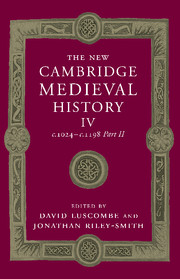Book contents
- Frontmatter
- 1 Introduction
- 2 The papacy, 1024–1122
- 3 The western empire under the Salians
- 4 Italy in the eleventh century
- 5 The kingdom of the Franks to 1108
- 6 Spain in the eleventh century
- 7 England and Normandy 1042–1137
- 8 The Byzantine Empire, 1025–1118
- 9 Kievan Rus’, the Bulgars and the southern Slavs, c. 1020 – c. 1200
- 10 Poland in the eleventh and twelfth centuries
- 11 Scandinavia in the Eleventh and Twelfth Centuries
- 12 Hungary in the Eleventh and Twelfth Centuries
- 13 The papacy, 1122–1198
- 14 The western empire, 1125–1197
- 15 Italy in the twelfth century
- 16 Spain in the twelfth century
- 17 The kingdom of the Franks from Louis VI to Philip II
- 18 England and the Angevin dominions, 1137–1204
- 19 Scotland, Wales and Ireland in the Twelfth Century
- 20 The Byzantine Empire, 1118–1204
- 21 The Latin East, 1098–1205
- 22 ’Abbasids, Fatimids and Seljuqs
- 23 Zengids, Ayyubids and Seljuqs
- Appendix: genealogical tables
- List of primary sources
- Bibliography of Secondary Works Arranged by Chapter
- Index
- Map 1a The western empire: Burgundy and Provence in the eleventh century"
- Map 1b The western empire: Germany and the north-eastern frontier of Christendom in the eleventh century"
- Map 3 The kingdom of the Franks"
- Map 4 England and Normandy"
- Map 10 Germany under Frederick Barbarossa, c. 1190">
- Map 12 The Angevin empire"
- References
6 - Spain in the eleventh century
Published online by Cambridge University Press: 28 March 2008
- Frontmatter
- 1 Introduction
- 2 The papacy, 1024–1122
- 3 The western empire under the Salians
- 4 Italy in the eleventh century
- 5 The kingdom of the Franks to 1108
- 6 Spain in the eleventh century
- 7 England and Normandy 1042–1137
- 8 The Byzantine Empire, 1025–1118
- 9 Kievan Rus’, the Bulgars and the southern Slavs, c. 1020 – c. 1200
- 10 Poland in the eleventh and twelfth centuries
- 11 Scandinavia in the Eleventh and Twelfth Centuries
- 12 Hungary in the Eleventh and Twelfth Centuries
- 13 The papacy, 1122–1198
- 14 The western empire, 1125–1197
- 15 Italy in the twelfth century
- 16 Spain in the twelfth century
- 17 The kingdom of the Franks from Louis VI to Philip II
- 18 England and the Angevin dominions, 1137–1204
- 19 Scotland, Wales and Ireland in the Twelfth Century
- 20 The Byzantine Empire, 1118–1204
- 21 The Latin East, 1098–1205
- 22 ’Abbasids, Fatimids and Seljuqs
- 23 Zengids, Ayyubids and Seljuqs
- Appendix: genealogical tables
- List of primary sources
- Bibliography of Secondary Works Arranged by Chapter
- Index
- Map 1a The western empire: Burgundy and Provence in the eleventh century"
- Map 1b The western empire: Germany and the north-eastern frontier of Christendom in the eleventh century"
- Map 3 The kingdom of the Franks"
- Map 4 England and Normandy"
- Map 10 Germany under Frederick Barbarossa, c. 1190">
- Map 12 The Angevin empire"
- References
Summary
the death of Muhammad ibn Abi ’Amir – better known to history by his honorific al-Mansur or Almanzor (’the Victorious’) – at Medinaceli on 11 August 1002 was doubtless greeted with grim satisfaction, not to say considerable relief, by the inhabitants of the realms of Christian Spain. For a quarter of a century al-Mansur had firmly held the reins of power in al-Andalus (Muslim Spain), eliminating his political rivals within the state bureaucracy in Cordoba and relegating the ruling Umayyad caliph, Hisham II (976–1009), to little more than a ceremonial role. Commanding fear and respect in roughly equal measure, al-Mansur’s authority as hajib, or chief minister to the caliph, and as de facto ruler of al-Andalus appears to have gone largely unchallenged. The sheer size and strength of the armies that he had under his command ensured that Cordoban control over the provinces of al-Andalus was never seriously called into question; just as they also enabled him to win considerable personal prestige, as well as impressive quantities of booty, by virtue of the devastating twice-yearly razzias that he led far and wide into Christian territory, from Barcelona in the north-east to Santiago de Compostela in the far north-west. By the beginning of the eleventh century al-Andalus was not simply the dominant political force in the Iberian peninsula, but it was probably the most powerful state in the entire western Mediterranean region, its boundaries stretching from North Africa to the Duero. Under al-Mansur’s rule, a writer later observed, ‘Islam enjoyed a glory which al-Andalus had never witnessed before, while the Christians suffered their greatest humiliation.’
Keywords
- Type
- Chapter
- Information
- The New Cambridge Medieval History , pp. 154 - 190Publisher: Cambridge University PressPrint publication year: 2004
References
- 1
- Cited by

